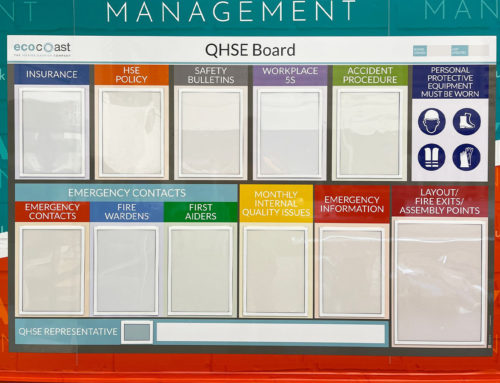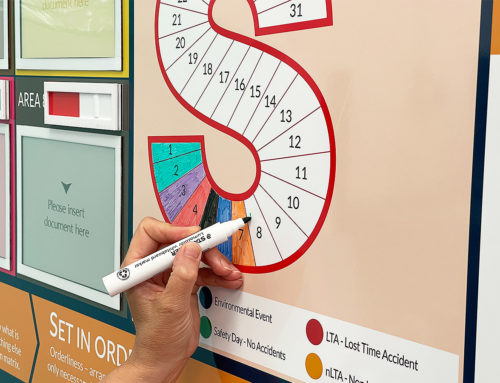Explore these 5 top tips for using visual management to make a visual workplace. Consequently, make key information visual, accessible and up-to-date. As a result, empower your team. Equally important, drive efficiency and deliver best practise.
Tip 1: Consider visual opportunities throughout your workplace
Firstly, offer visual cues everywhere possible. Secondly, take every opportunity to make key information instantly visible. Particularly, for example, for important data that might otherwise be inaccessible. Perhaps, for instance, because it is out of sight within a computer or filing system. Above all, give it visibility, at a glance. Therefore, make it visual and, as a result, quick and easy to access. In other words, eliminate any barriers to important information. Therefore, improve workflow and increase efficiency.
Tip 2: Think beyond walls and floors
In short, see everywhere as an opportunity for creating a visual workplace. That is to say, think beyond walls or floors.
Certainly, wall mounted boards, full wall visuals and, likewise, floor markings successfully make key information visible. Nevertheless, remember ceilings, machinery, equipment, shelving, windows, doors, lockers and even bins. Consequently, see how all these offer opportunity for creating a visual workplace.
Furthermore, reception areas, meeting rooms, offices, production lines, changing rooms, corridors, warehouses and dispatch yards. All offer opportunities to make vital information visible and accessible, at a glance.
In addition, evaluate what type of visual displays work best. For example, mobile boards offer flexibility. For instance, because they have the scope to move visual information through a process area.
Tip 3: take a custom approach to visuals
Creating a visual workplace requires a custom approach. So, above all, your visuals need to reflect your own processes. Likewise, the way your team works and engages. Most importantly, custom means much more than choosing the type and size of visual.
Most importantly, a custom approach delivers the content and information you need to show on your visuals. Likewise, it reflects choosing exactly the metrics, data and status updates you need. In addition, with the best options for making real time updating a sustainable habit for your team.
Without a doubt, avoid generic visuals that blend into the background. Consequently, embrace stand out, striking and effective visuals. Furthermore, put in place visuals that deliver meaningful resonance with your team.
Tip 4: just make a start
One of the most valuable ways forward in creating a visual workplace is to make a start. It may seem obvious but there are valid points to unpack here.
Firstly, consider how to start. For instance, is it better to implement visuals in a small way initially? So, for example, one SQDC board in one department. Moreover, which are your most important areas or departments to address?
On the other hand, do you have a larger plan? Perhaps, for instance, you have your sights set on creating a performance obeya. In this case, therefore, do you want to take a wider site approach from the off?
Ultimately, while both ways forward have merit, the crucial point is to make that start. Above all, starting somewhere – even if only in a small way – is the game changing action to take. In brief, making a start provides a foundation on which to build.
Tip 5: use the process of creating a visual workplace to inspire teamwork
So, think about how the process of implementing visuals can engage your team. Creating a visual workplace kickstarts an invaluable thinking process. Above all, this is fruitful. In other words, equally important to delivering striking visuals is the clear thinking and teamwork underpinning them.
A right approach here will add to an organisation’s culture. Likewise, ensure good habits stick. As a result, enjoy an ever tidier, better organised and a more efficient workplace. In addition, empower your team.
Want help creating a visual workplace?
Please feel welcome to start now
Take every opportunity to create a visual workplace and make important information visible, accessible and engaging
Think beyond walls. Entrances, exits, corridors, lockers and even bins, for example – all offer opportunity for visual cues to support the team
Consider creating a dedicated space for clear thinking and decision making. For example, like this performance centre.
Exchange bland, plain corridors for engaging visuals that show key values.
Resolve issues with visual cues to get to the heart of root causes. As a result, support efficient problem solving.
Above all, take a custom approach to visuals. Therefore, show what you need and in the way that works best.
Even if just one visual, the most important action to take is to make a start.
Further examples of our Visual Management Boards
Our Approach
We create visual management boards everyday. As a result we have plenty of experience. We work for organisations in food production, the power industry, national rail, pharmaceuticals, education, healthcare, packaging and distribution.
Our team works with a simple idea or sketch and creates a professionally designed layout. This is then turned into a highly functional visual management board.
We offer customised options because we want to create the perfect board for you. So, here are a few examples. We can add magnetic areas or a dry-wipe finish (for use with whiteboard pens). Furthermore, you can choose Red/Green sliders or R.A.G. (Red, Amber, Green) status dials so you can quickly and visually update your board. These are just a few examples of the ways in which our boards can be tailored to meet your needs. You may also be interested in whiteboard overlays that can be used on top of an existing magnetic board.





















































